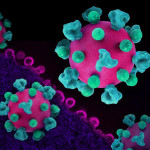People living with HIV are at greater risk for cardiovascular disease (CVD) compared with the general population, but managing risk factors such as elevated cholesterol, blood sugar and high blood pressure (hypertension) makes a difference, according to recent research.
“We’ve done the clinical epidemiology and we’ve done the clinical trials,” but now we need strategies to implement the findings, Christopher Longenecker, MD, of the University of Washington in Seattle, told reporters at the Conference on Retroviruses and Opportunistic Infections (CROI 2024).
Experts generally estimate that HIV-positive people have about a twofold higher risk for CVD and experience cardiovascular complications at younger ages than their HIV-negative peers. But this depends on their risk factors and how well they are controlled.
As described in Clinical Infectious Diseases, Michael Silverberg, PhD, MPH, of Kaiser Permanente Northern California, and colleagues analyzed the impact of CVD management in people with and without HIV.
This retrospective analysis included 8,285 HIV-positive and 170,517 HIV-negative members of a large integrated health system. Most were men, about half were white and the median age was approximately 47 years.
The researchers used a disease management index to assess control of hypertension (systolic and diastolic blood pressure, or the top and bottom numbers in a reading), diabetes (HbA1c) and dyslipidemia (low-density lipoprotein [LDL], total cholesterol and triglycerides). Elevated LDL, or “bad cholesterol,” is a risk factor for CVD, while high-density lipoprotein (HDL), or “good cholesterol,” is considered protective.
In general, people with and without HIV had “excellent and similar levels” of risk factor management (between 80% and 100%), except HIV-positive people had better blood sugar control but worse triglyceride management.
Overall, people with HIV had about a 20% higher risk for cardiovascular events. HIV-positive people with no risk factors still had elevated CVD risk, indicating that HIV-specific factors—such as immunosuppression and inflammation—play a role. CVD risk was attenuated in HIV-positive people with well-controlled blood lipids and diabetes. However, their risk remained elevated despite well-controlled hypertension.
The difference between HIV-positive and HIV-negative people with uncontrolled risk factors was not statistically significant, suggesting that the effect of HIV matters less when other risks are present. The exception was alcohol. The excess risk was more than 200% higher for HIV-positive people with frequent heavy alcohol use, indicating that alcohol may have a more detrimental effect in this population.
These results show that managing CVD risk factors is beneficial for people with HIV, but they may require intervention at lower thresholds. A analysis from the REPRIEVE trial presented at CROI confirmed that a standard risk calculation underestimates CVD risk for HIV-positive people, especially women and Black people. The risk of having a first major cardiovascular event was higher than previously predicted for HIV-positive people from high-income countries and those with a detectable viral load.
As previously reported, REPRIEVE showed that daily pitavastatin (Livalo) reduced the risk for heart attacks, strokes and other major cardiovascular events by 35% among HIV-positive people with low to moderate CVD risk—a group that would not ordinarily be prescribed a statin. Based on these findings, both the U.S. Department of Health and Human Services and the British HIV Association have updated their guidelines to recommend statins for HIV-positive people ages 40 and older with low or intermediate CVD risk.
The new findings further suggest that “more aggressive clinical targets for dyslipidemia and hypertension may be needed for people with HIV,” Silverberg and colleagues concluded.
Managing High Blood Pressure
Two other studies presented at CROI looked at interventions for managing hypertension in people with HIV, as high blood pressures is a major risk factor for heart attacks and strokes.
One study, presented by Lily Yan, MD, of Weill Cornell Medicine, showed that earlier treatment with the calcium channel blocker amlodipine (Norvasc and generics) improved hypertension in people with HIV. This analysis included 250 adults on stable antiretroviral therapy with viral suppression who received care at the GHESKIO HIV clinic in Port-au-Prince, Haiti. At baseline, they had “prehypertension,” or blood pressure slightly above the normal range, with systolic readings between 120 and 139 and diastolic readings between 80 and 89 mm Hg.
The participants were randomized to either receive early treatment for prehypertension or standard care, in which people start therapy only if they develop hypertension (blood pressure 140/90 or higher). Currently, the World Health Organization recommends initiation of antihypertensive treatment for people with a reading of 140/90, regardless of HIV status. The American Heart Association considers blood pressure below 120/80 to be normal, up to 129/79 to be elevated, up to 139/89 to be Stage 1 hypertension and 140/90 or higher to be Stage 2 hypertension.
People in the early intervention group were 57% less likely than standard care recipients to develop hypertension during a year of follow-up (40% versus 64%). Conversely, they were 59% more likely to achieve blood pressure control, meaning a reading under 120/80 (57% versus 37%). No treatment-related serious adverse events were observed, and participants reported that the treatment was acceptable.
Lowering the threshold for antihypertensive treatment for people living with HIV, similar to current recommendations for people with diabetes or kidney disease, “may be an important tool for cardiovascular disease prevention,” Yan said.
In the second trial, dubbed EXTRA-CVD, Longenecker and colleagues evaluated a nurse-led intervention for HIV-positive people with established hypertension and elevated cholesterol. The findings were also published in JAMA Network Open.
The study enrolled 297 people with viral suppression at three academic HIV clinics in North Carolina and Ohio. Nearly 80% were men, about 60% were Black and the mean age was 59. At baseline, about half were already prescribed at least two antihypertensive drugs and two thirds were taking statins.
Over the course of a year, those in the intervention groups received guidance on home blood pressure monitoring along with blood pressure and cholesterol management and adherence support provided by a dedicated prevention nurse at four quarterly visits. Participants also received telephone check-ins as often as every two weeks if needed. Those in the control group received general prevention education at four in-person sessions.
People assigned to the program saw a greater decrease in systolic blood pressure (4.2 mm Hg lower) and a larger reduction in LDL and other non-HDL cholesterol (16.9 mg/dL lower) compared with the control group. The reduction in non-HDL was mainly driven by decreased triglycerides rather than LDL. A prior meta-analysis suggested that a 4.2 mm Hg reduction in systolic blood pressure could lead to a 14% decrease in CVD events, while a 16.9 mg/dL decline in non-HDL cholesterol could reduce the risk by 9%, the researchers noted in their discussion.
What’s more, people assigned to the intervention group were three times more likely to reach the blood pressure treatment goal (systolic BP under 130) and seven times more likely to reach cholesterol goals (non-HDL under 100 mg/dl for higher-risk individuals or under 130 mg/dl for people at lower risk). The effect of the intervention on blood pressured appeared to be greater for women.
They study authors noted that one barrier to optimal CVD care is that some HIV clinicians provide comprehensive primary care while others focus on antiretroviral treatment and direct HIV-related care. “Fragmented care may lead to poor communication between HIV and non-HIV care practitioners, further fueling people with HIV’s mistrust in non-HIV clinicians and leading people with HIV to value adherence to antiretroviral therapy over blood pressure and cholesterol medications,” they wrote.
As guidelines expand the indication for statin therapy following REPRIEVE, “innovative strategies, such as EXTRA-CVD, will become even more relevant to the implementation of atherosclerotic CVD prevention care in HIV clinics,” they concluded. “Although the EXTRA-CVD intervention was limited to blood pressure and cholesterol, nurse-led case management might be beneficial for a range of other primary care conditions in HIV clinics.”
Click here to learn more about HIV and heart health.
Click here for more reports from CROI 2024.







Comments
Comments